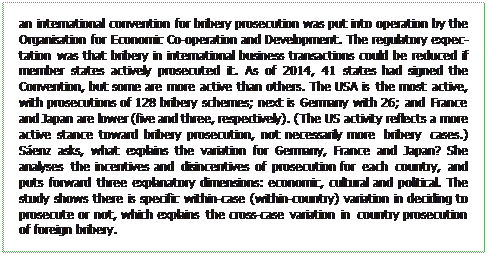 |
Comparative criminology. Summary and review
|
|
|
|
COMPARATIVE CRIMINOLOGY
Although my research and that by Pennington had comparative elements, our focus differed from what is commonly featured in comparative social science or comparative criminology. In these areas, the unit of analysis is a nation-state, although as Karstedt (2012) suggests, it may also be useful to focus on socio- cultural units.
In the last decade, there has been an explosion of interest by criminologists in comparative study (for review, see Karstedt, 2012). In part, this reflects an interest in examining the impact of globalization; in part, to better understand crime and justice in the developing world; and in part, to analyse mass atrocities and justice in countries in transition from civil war or state repression to more democratic forms. The example in Box 21. 6 reflects the first area of interest, with a comparative analy- sis of international regulation of bribery. Sá enz (2015) compares Germany, France and Japan to determine why Germany is more compliant than the other two in prosecuting foreign bribery.
 |

SUMMARY AND REVIEW
This chapter has described the aims and applications of case study research, and compared it with cross-case research. Five points have been advanced. First, case study research may use qualitative and quantitative evidence to describe and explain a case in depth; for that reason, it would be misleading to call case study research qualitative, and more accurate to call it a hybrid form. Second, case study researchers are obliged to address the question, ‘what is this a case of ? ’ In some research, this may not be certain at the start, but will require continual reflection as the project evolves. Third, how and why cases are selected is a critical decision. Researchers should be cognizant of the selection rule(s) they use, and they should discuss what they did and why in papers that report results. Fourth, approaches to knowledge building in the social sciences – positivist and interpretive, among others – vary. This, along with differing disciplinary concerns, means that there is no one authoritative source for doing case study research. My chapter relied on Gerring’s (2007/2017) work for its clarity and comprehensiveness. Fifth, all research methods have strengths and weaknesses, which should be viewed as trade-offs. In general, when you want to know the ‘how and why’ of social phe- nomena, case study research would be your choice. When you want to know ‘who, what, where, how many, and how much’ (Yin, 1994: 6), then cross-case research may be preferable.
Looking to the future, criminology will benefit by an awareness of the value and
sophistication of case study research and by seeing it as an equal partner with cross- case research.

 STUDY QUESTIONS AND ACTIVITIES FOR STUDENTS
STUDY QUESTIONS AND ACTIVITIES FOR STUDENTS
1. ‘Case study research is qualitative research. ’ Discuss this claim and illustrate with examples.
|
|
|
2. What is case selection in case study research? Why is it a crucial step in the research process?
3. Becker (1999) says that what a case study is ‘a case of’ may not be known until the conclusion of the research, and that the less sure a researcher is at the start, the better the research may be. What does he mean?
4. How is case study research related to cross-case research?
5. What is the difference between comparative case study research and compara- tive criminology?
6. Locate a journal article that uses case study research. Review it with reference to these questions. What is it a case of? Did the author(s) provide a clear and well- defended explanation of the method used in case selection? Would you have carried out the study differently? Why or why not?
7. Locate three texts on case study research. Review them with reference to how these terms are defined: a case, a case study, and case selection. What are the points of similarity and difference?
8.  Identify a problem in crime and justice that interests you. How would you carry out research on it using a case study method? What would you hope to learn from the case study? How would what you could learn differ from a research design that used a cross-case method?
Identify a problem in crime and justice that interests you. How would you carry out research on it using a case study method? What would you hope to learn from the case study? How would what you could learn differ from a research design that used a cross-case method?

 REFERENCES
REFERENCES
Backer, D. (2009) ‘Cross-national comparative analysis’, in H. van der Merwe, V. Baxter and
A. R. Chapman (eds), Assessing the Impact of Transitional Justice. Washington, DC: United States Institute of Peace Press, pp. 13–89.
Becker, H. (1999) ‘The Chicago School, so-called’, Qualitative Sociology, 22(1): 3–12. Cohen, S. (1972) Folk Devils and Moral Panics. London: Granada Publishing.
Daly, K. (2014) Redressing Institutional Abuse of Children. Basingstoke: Palgrave Macmillan.
Daly, K. (2017) ‘Sexual violence and victims’ justice interests’, in E. Zinsstag and
M. Keenan (eds), Sexual Violence and Restorative Justice: Legal, Social and Therapeutic Dimensions. London: Routledge, pp. 108–39.
Elman, C., Gerring, J. and Mahoney, J. (2016) ‘Case study research: putting the quant in the qual’, Sociological Methods & Research, 45(3): 375–91.
Gaarder, E. (2015) ‘Lessons from a restorative circles initiative for intimate partner vio- lence’, Restorative Justice: An International Journal, 3(3): 342–65.
George, A. L. and Bennett, A. (2005) Case Studies and Theory Development in the Social Sciences. Cambridge: The MIT Press.
Gerring, J. (2007/2017) Case Study Research: Principles and Practices (1st and 2nd editions). Cambridge: Cambridge University Press.
Gies, L. (2017) ‘Miscarriages of justice in the age of social media: the Amanda Knox and Raffaele Sollecito innocence campaign’, British Journal of Criminology, 57(3): 723–40.
Goffman, E. (1961) Asylums. Garden City, NY: Anchor Books.
Hayner, P. B. (2011) Unspeakable Truths: Transitional Justice and the Challenge of Truth Commissions, 2nd edition. New York: Routledge.
Karstedt, S. (2001) ‘Comparing cultures, comparing crime: challenges, prospects and problems for a global criminology’, Crime, Law and Social Change, 36: 285–308.
Karstedt, S. (2012) ‘Comparing justice and crime across cultures’, in D. Gadd, S. Karstedt and S. F. Messner (eds), The SAGE Handbook of Criminological Research Methods. London: Sage, pp. 373–89.
|
|
|
Kelley, K. and Gruenewald, J. (2015) ‘Accomplishing masculinity through anti-lesbian, gay, bisexual, and transgender homicide: a comparative case study approach’, Men and Masculinities, 18(1): 3–29.
Lewis, P., Newburn, T., Taylor, M., Mcgillivray, C., Greenhill, A., Frayman, H. and Proctor,
R. (2011) Reading the Riots: Investigating England’s Summer of Disorder. London:
 Reading the Riots, The London School of Economics and Political Science (LSE) and The Guardian. Available at: http: //eprints. lse. ac. uk/46297 (accessed May 2018).
Reading the Riots, The London School of Economics and Political Science (LSE) and The Guardian. Available at: http: //eprints. lse. ac. uk/46297 (accessed May 2018).
Liebow, E. (1967) Tally’s Corner: A Study of Negro Streetcorner Men. Boston: Little, Brown. Merriam, S. B. (1998) Qualitative Research and Case Study Applications in Education. San
Francisco: Jossey-Bass.
Mills, A. J., Durepos, G. and Wiebe, E. (eds) (2010) Encyclopedia of Case Study Research, Vols I and II. Thousand Oaks, CA: Sage.
Newburn, T. (2015) ‘The 2011 English riots in recent historical perspective’, British Journal of Criminology, 55(1): 39–64.
Newburn, T., Cooper, K., Deacon, R. and Diski, R. (2015) ‘Shopping for free? Looting, consumerism and the 2011 riots’, British Journal of Criminology, 55(5): 987–1004.
Pennington, L. (2015) ‘A case study approach to procedural justice: parents’ views in two juvenile delinquency courts in the United States’, British Journal of Criminology, 55(5): 901–20.
Piekkari, R., Welch, C. and Paavilainen, E. (2010) ‘Pluralism and case study’, in A. J. Mills,
G. Durepos and E. Wiebe (eds), Encyclopedia of Case Study Research. Thousand Oaks, CA: Sage.
Platt, J. (1992) ‘“Case study” in American methodological thought’, Current Sociology, 40: 17–48.
Plummer, K. (2003) ‘Continuity and change in Howard S. Becker’s work’, Sociological Perspectives, 46(1): 21–39.
Ragin, C. C. (1987/2014) The Comparative Method: Moving Beyond Qualitative and Quantitative Strategies (1st and 2nd editions). Oakland, CA: University of California Press.
Ragin, C. C. (1992) ‘Introduction: cases of “what is a case? ”’, in C. C. Ragin and
H. S. Becker (eds), What is a Case? Exploring the Foundations of Social Inquiry. Cambridge: Cambridge University Press, pp. 1–52.
Sá enz, S. C. (2015) ‘Explaining international variance in foreign bribery prosecution: a com- parative case study’, Duke Journal of Comparative & International Law, 26: 271–98.
Stack, C. (1974) All Our Kin: Strategies for Survival in a Black Community. New York: Basic Books.
Stake, R. E. (1995) The Art of Case Study Research. Thousand Oaks, CA: Sage.
Whyte, W. F. (1943/1981) Street Corner Society: The Social Structure of an Italian Slum. Chicago: University of Chicago Press.
Yazan, B. (2015) ‘Three approaches to case study methods in education: Yin, Merriam, and Stake’, The Qualitative Report, 20(2): 134–52.
Yin, R. K. (1984/1994/2014) Case Study Research: Design and Methods (1st, 2nd and 5th editions). Thousand Oaks, CA: Sage.
|
|
|


